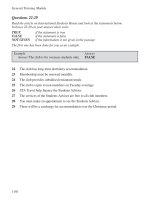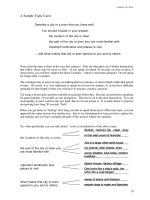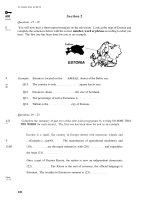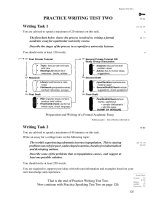101 helpful hints for ielts part 8
Bạn đang xem bản rút gọn của tài liệu. Xem và tải ngay bản đầy đủ của tài liệu tại đây (109.06 KB, 15 trang )
101 Helpful Hints for IELTS
610 Section 2
23-25
Questions 15 -18
8 You will now hear a short report broadcast on the television. Look at the map of Estonia and
16'17 complete the sentences below with the correct number, word or phrase according to what you
hear. The first one has been done for you as an example.
Tallinn
Check:
11-15
ESTONIA
9 Example: Estonia is located on the &M&&f:. shores of the Baltic sea.
is Q15. The country is only square km in size.
20
Q16. Estonia is about the size of Scotland.
Q17. The percentage of native Estonians is
Q18. Tallinn is the city of Estonia.
Questions 19 - 23
8-23 Complete the summary of part two of the television programme by writing NO MORE THAN
25 TWO WORDS for each answer. The first one has been done for you as an example.
Estonia is a small, flat country in Europe dotted with numerous islands and
9 ... (Example:)....fa&€4. The manufacture of agricultural machinery and
12-65' (19) are the major industries, with (20) and vegetables
the main (21)
Once a part of Greater Russia, the nation is now an independent democratic
(22) The Kroon is the unit of currency; the official language is
Estonian. The weather in Estonia in summer is (23)
110
Questions 24 - 32
Practice Test Two
Section 3 6-io
23-26-29
You will hear an interview with an ex-student of the college. Write a word or a short phrase 8
to answer each of the questions below. The first one has been done for you as an example. 16"17
Example: How many years ago was Anna a student at the college? 9
Q24. Who does Anna currently work for? 1920
Q25. Why are some elderly people provided with food by the council?
Q26. When did Anna discover her progress in the first course was unsatisfactory?
Q27./Q28. Name two of the suggestions made to Anna by the school counsellor: 7 -19
(1)
(2)
Q29. What does Anna do to increase her English vocabulary?
Q30. According to Anna, does eating earlier in the day increase the metabolic rate?
Q31. Why does Anna wish to get a job in a hospital soon?
Q32. What is Anna's long-term goal?
Check:
11-15
111
101 Helpful Hints for IELTS
6-10
34-35
8
16-17
Section 4
Questions 33 - 40
You will hear part of the Student Orientation to the computer laboratory.
Circle A if the information in the statement is Accurate
I if the information in the statement is Inaccurate
N if the information in the statement is Not Given
The first one has been done for you as an example.
Example: There are over 100 computers in the laboratory.
Your Answers
I I N
34
20
34
34
Q33. Students only need to enter their name to log on to the machines. A I N
Q34. If something goes wrong on a computer, you should not turn the A I N
machine off.
Q35. Student computer disks are sometimes allowed in the laboratory. A I N
35
35
Q36. The Macintosh computer network can only be used by second A I N
and third year students.
Q37. After class hours there is a charge per page for the use of all A I N
computer printers.
Q38. The computer laboratory is open at 8.00 am during the week.
A I N
Q39. The computer lab card shows a student's name, course and A I N
log on number.
Q40. Students are expected to follow 5 computer laboratory rules. A I N
Overall Check:
Blanks: 11
Grammar 12
&65
One Answer 13
Spelling: 14
Legibility: IS
Punctuation: 591
That is the end of Practice Listening Test Two.
You now have 10 minutes to transfer your answers to the Answer Sheet.
Then continue with Practice Reading Test Two on page 113.
112
Practice Test Two
PRACTICE READING TEST TWO
Reading Passage 1
Questions 1-15
You are advised to spend about 20 minutes on Questions 1-15.
TRACKING HURRICANES
North American meteorologists from the National Oceanic
and Atmospheric Administration (NOAA)'s Hurricane
Research Division have recently improved the success rate in
their forecasting of where hurricanes are likely to hit land by an estimated 15 to 30%.
This increase in accuracy is due to the use of instruments called GPS-dropwindsondes,
which can probe the atmosphere surrounding a hurricane while it is still out at sea. The
atmospheric characteristics of hurricanes over land are well understood because
investigation is possible with weather balloons containing sophisticated meteorological
instruments. When hurricanes are out of reach of balloons, gathering information is
decidedly more difficult. Little is known of the weather conditions that guide hurricanes
towards land.
An accurate estimation of where a hurricane will strike is essential in order to reduce
loss of life and property. Hurricane Andrew, the most costly hurricane in U.S. history,
killed 15 people and caused damage of $35 billion, in today's dollars, in 1992.
However, the unnamed: Category 42 hurricane which struck southeast Florida in 1926
and killed 243 people would have caused an estimated $77 billion if it had struck today.
The reason for this is the explosion in population growth and development along the
south-east coast of the U.S. during the last half century.
Hurricanes occur in cycles every few decades, the last intense period in the U.S. being
from 1940 to 1969. 'Camille', a Category 5 hurricane of such catastrophic force that
it caused over a billion and a half dollars worth of damage at the time and killed 256
people, struck the coast of the Gulf of Mexico in 1969 with winds over 320 km/h. Yet,
for the last quarter century, hurricane activity has been relatively mild. Scientists do
not know the precise reason for the cycles of hurricane activity, but they could be caused
by a phenomenon called the 'Atlantic Conveyor'. This is the name given to the gigantic
current of water that flows cold from the top of the globe slowly along the Atlantic ocean
floor to Antarctica and resurfaces decades later before flowing back north, absorbing
heat as it crosses the equator. Since hurricanes derive their energy from the heat of
warm water, it is thought that an increase in the speed of the' Conveyor', as it pulls warm
water to the north, is an indicator of intensifying hurricane activity.
The use of GPS-dropwindsondes began in 1997. Small sensing devices dropped from
planes at very high altitudes and over a wide area, they are far more revealing than
previously used sensors. Because they weigh only 0.4 kilograms, they are able to stay
aloft for longer periods and broadcast more data to the ground. Each sonde carries its
own global positioning satellite receiver. The GPS signals received are used to calculate
the direction and speed of wind, and data on temperature, humidity, and barometric
pressure at half second intervals all the way down to the ocean surface.
113
DunngTest
6-10-37
38-44
54-56-57
101 Helpful Hints for IELTS
Dropwindsonde information is fed into a special meteorological computer in Maryland
which generates a global computer model of wind patterns. Data analysts have
discovered a greater variability in the winds at sea level than previously believed, but
many forecasting problems are beyond a solution, at least for the time being. For
instance, it is not yet known why hurricanes can suddenly change in intensity; current
computer models often fail to predict whether a hurricane will reach land or else cannot
pinpoint where a strike will take place.
One surprising result of a recent computer simulation was the destruction of a large part
of downtown New York. Hurricane researchers believe that the city is more likely than
Miami to suffer a direct hit in the near future. Also, certain geographical features of
the coastline near New York make it conceivable that a wall of water called a storm
surge pushed ashore by hurricane winds would cause a devastating flooding of
Manhattan. A storm surge was responsible for the more than 8000 deaths caused by
the hurricane that destroyed the city of Galveston in 1900.
1 the custom of naming hurricanes began in the early 1950s
2 hurricanes are categorised according to their wind speed from Category 1 (least intense)
to Category 5 (most intense)
6
8
26-27
43-57
9
65'
56
52-54
54'591
Check:
11-15
Questions 1 - 4
You are advised to spend about 5 minutes on Questions 1-4.
Refer to Reading Passage 1 "Tracking Hurricanes", and look at Questions 1 - 4 below. Write
your answers in boxes 1 - 4 on your Answer Sheet. The first one has been done for you as an
example.
Example: What do the letters NOAA stand for?
Ql. Which instruments have recently increased the success rate of U.S.
hurricane forecasts?
Q2. What reason is given for the lack of knowledge of hurricanes at sea?
Q3. Why was the hurricane which struck in 1926 not given a name?
Q4. What is the name of the strongest hurricane mentioned in the article?
114
Practice Test Two
Questions 5-11
You are advised to spend about 8 minutes on Questions 5-11.
Look at the table below. According to Reading Passage 1, to whom or what do the phrases on
the right refer? Write your answers in boxes 5 -11 on your Answer Sheet. The first one has been
done for you as an example.
Note that you must give your answer IN NO MORE THAN THREE WORDS.
have improved their forecasts for hurricanes.
Q5 ... become stronger every few decades.
Q6 ... energises all hurricanes.
Q7 ... is a huge current of water flowing from
north to south.
Q8 ... could not stay in the air for a long time.
Q9 ... know more about surface winds than
they knew before.
Q10 ... recently predicted a catastrophe for the
city of New York.
Qll ... is a huge wave of water blown on land
by a hurricane.
Questions 12 -15
You are advised to spend about 7 minutes on Questions 12-15.
Refer to Reading Passage 1, and decide which of the answers best completes the following
sentences. Write your answers in boxes 12 -15 on your Answer Sheet. The first one has been
done for you as an example.
Example: The main point of the passage is to give information about:
a) previous U.S. hurricanes
b) future U.S. hurricanes
c) forecasting hurricane activity
why hurricanes change in intensity
115
Who or What ?
6
8
44-46
53
9
65'
49
44
44
49-65
42-43
42-49
Check
11-15
6
8
30-33
40-43
9









